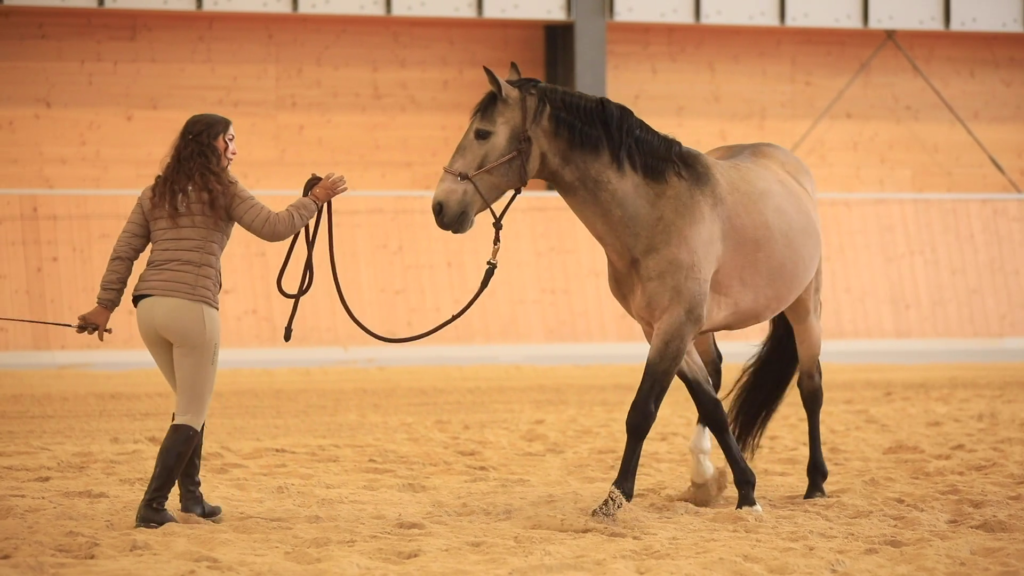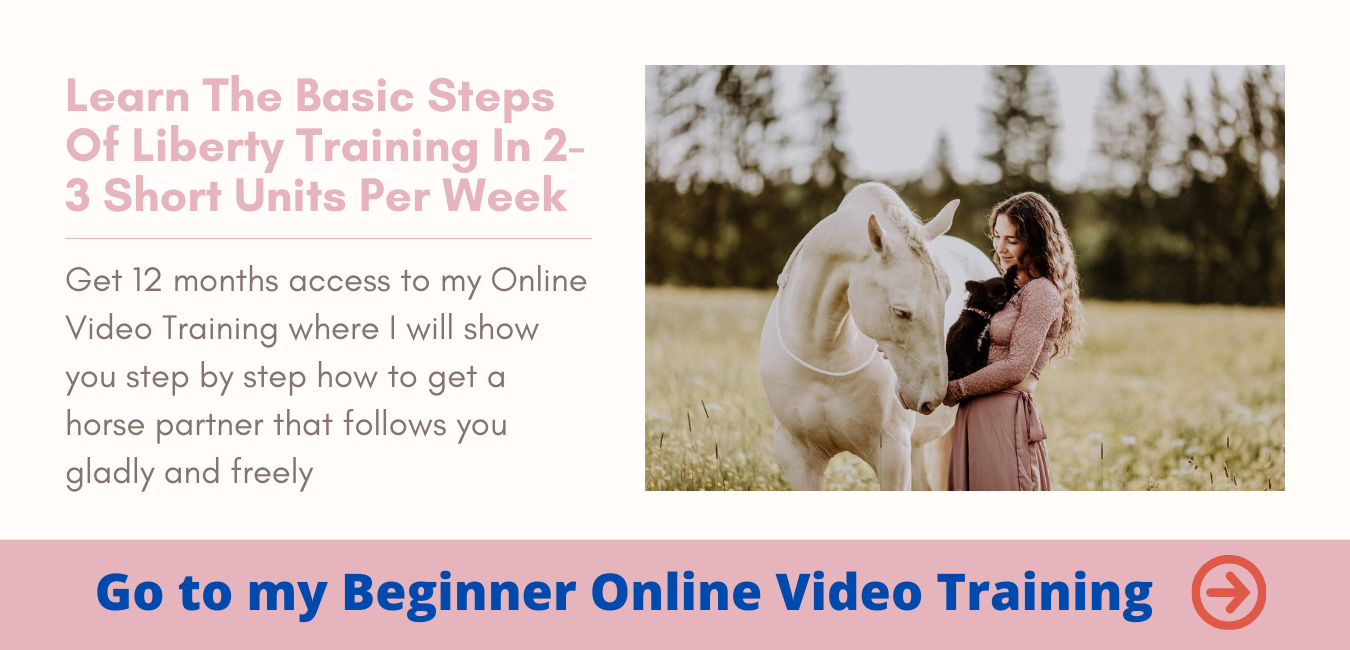Have you already tried the circling? And almost got “tangled up” from time to time?
The change of direction in free circling really works completely different than in lunging.
And that’s why I’d like to explain this part to you in detail today, so that you don’t get a twirling bug because you’re only circling with your horse on one hand ?.
The handling of rope and rope is different and the horse even changes in one direction behind your back!
But don’t worry: once you get the hang of it, the change is even easier than lunging, because I don’t have to change whip or rope in my hand.
This also takes some practice, but is really practical in the long run – especially, of course, with a view to working freely on the circle at some point.
Let’s start on the left hand.
There you stand in the “leading position”. You have the whip in your left hand, the rope in your right. You stand sideways next to your horse – just like when leading.
If the leading exercises are really good, your horse will now hold its position next to your shoulder and circle around you.
If your horse drifts away to the outside, you can give gentle impulses with the rope in your direction.
My empty hand without the rope still carries out these impulses – this hand movement has established itself as a visual impulse for Sasou, so to speak, even without the rope.
So he pays attention to this “inviting gesture” even without tension on the rope – perhaps keep this in mind from the beginning when working with your horse!
If your horse comes too close to you, simply raise your right hand with the rope to his eye level.
And send your horse with gentle movements in the direction of the eye (please do not touch!) further away from you.
Your arm length is, so to speak, your “spacer”, which ensures that your horse respects your dance area on this hand.
Your horse – a board?
The left hand with the whip is responsible for driving the horse.
Or for bringing the horse closer to you again. You can imagine your horse like a board: If you drive the hindquarters outward, the forehand automatically comes to you.
Attention: Test this on the rope first, otherwise your horse may run away from you – especially if your impulse with the whip was too strong! Feel your way in slowly.
Likewise, you may have noticed that when your horse’s head and forehand drift away from you, the hindquarters come quite close.
Just think about how you bring an energetic horse into the paddock.
You turn it towards you after the entrance, turn it loose and as soon as it turns, the hind end is often closer than you would like.
But the turn gives you time to step out of the “danger zone”.
When lunging – especially on the small circle – it is therefore useful to keep this “board effect” in mind and to make sure that the head and forehand stay with you the whole time.
The change from the left to the right hand
The change from the left to the right hand back (i.e. from the lead position to the lungeing position) is often easier in the beginning, because you have your horse in sight the whole time.
For this change you make yourself small and take a step back to give your horse room to turn around to the inside.
I now take hold of the whip in my hand so that it lies comfortably again – but I do not change the whip to the other hand!
With large circular movements and a turn in the upper body that visually “closes the door” on my horse (Say: Push the left shoulder forward and take the right shoulder back) I send my horse in front of me to the other hand.
By the way, the step backwards to make room for your horse can be smaller and smaller with time, so that your horse really sits on the hindquarters and jumps rather than walks the change like Sasou.
The right hand is now more like what you know as “lunging”.
There you stand in a “normal” lunge position, so to speak. The whip is in your left hand, the rope in your right. Your belly button points in the direction of your horse’s shoulder.
You make sure that your shoulder, which is pointing in the direction of movement, is always slightly turned backwards – because this way you visually “open the door” for the horse and he can move smoothly in the desired direction.
You are not standing completely parallel to your horse, but slightly to the side.
If your horse drifts away to the outside on this hand, you can give gentle impulses with the rope in your direction.
My empty hand without the rope still carries out these impulses – this hand movement has established itself as a visual impulse for Sasou, so to speak, even without the rope.
So he pays attention to this “inviting gesture” even without tension on the rope – perhaps keep this in mind from the beginning when working with your horse!
Many changes of direction for more attention & elasticity
By the way, many changes of direction keep your horse alert!
They also make your horse more agile because (depending on how small your circle is and how much space you give him) he really has to sit on his hindquarters.
Be sure to pay attention here to how much your horse can do depending on his age, training level, and health, and respect his limits!
At this point, I should probably mention again that your horse should never enter your dance area or maybe even push you away!
If your horse comes too close to you, make yourself tall, do not retreat (if possible!) and if necessary send him away from you again with the whip – because a lack of safe distance and respect can quickly become dangerous!
If your horse tends to be so rowdy, impetuous or disrespectful, you should even take another step back and work on your horse really respecting your dance area.
The change from the right to the left hand
If you now want to change the hand from the lungeing position back to the lead position, i.e. from the right to the left hand, it is extremely helpful if your horse knows the lead position really well.
Because then he knows very quickly what you want him to do – even if you can’t see him.
Your horse changes hands behind you, so you don’t have quite as much influence as you do with a normal change during lunging.
For the change, you make yourself small and turn to the left – facing the hindquarters.
In this way, you “push” the hindquarters away to the outside, so to speak, and at the same time take a small step backwards in the turn and lift the tip of the crop upwards to “block” your horse’s further path on the right hand.
Your horse is now actually already in the turn due to the turn with the hindquarters and can easily “follow” a few steps with the forehand to get to your shoulder and thus into the lead position.
Don’t worry, this sounds more complicated than it is!
Because all this may not be immediately understandable as a text, I have cut you the change with and without rope again from video together.
Good Training: Balance & Strength
Some horses simply lack the balance or strength to change direction in such a tight turn.
Start with the changes on a slightly larger circle at a walk and work on your horse learning to coordinate better and to take the load on the hindquarters.
Especially with young horses, it can take a while until they can perform the change smoothly at the trot.
Important: Old horses that are perhaps already a little stiff, can often no longer jump the change of direction as Sasou. Take also here absolutely consideration and do not overtax your horse!
But now, have fun changing direction without roping ? Once you get the hang of it, this type of change is really super practical and enjoyable – and with enough energy and balance, it will eventually even look pretty spectacular!
All the love,
Kenzie
P.S.: Click here to watch the video “The change of direction while circling”.
[su_youtube url=”https://youtu.be/xxWHoC2yhgI”]




